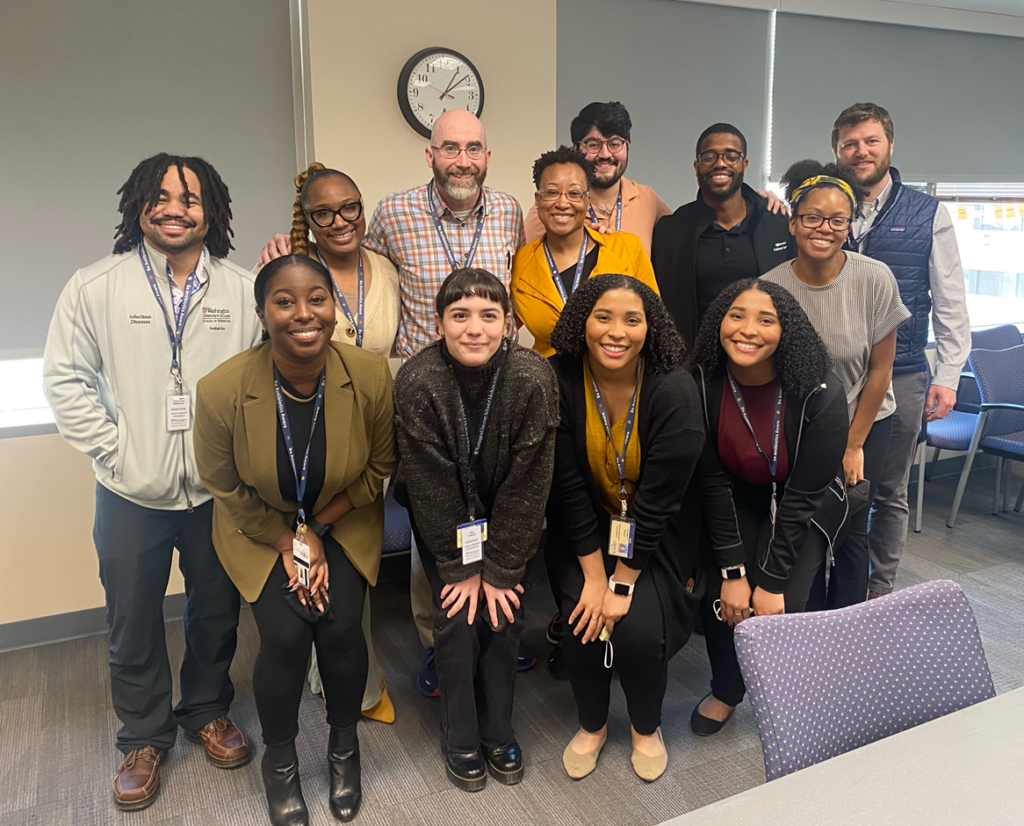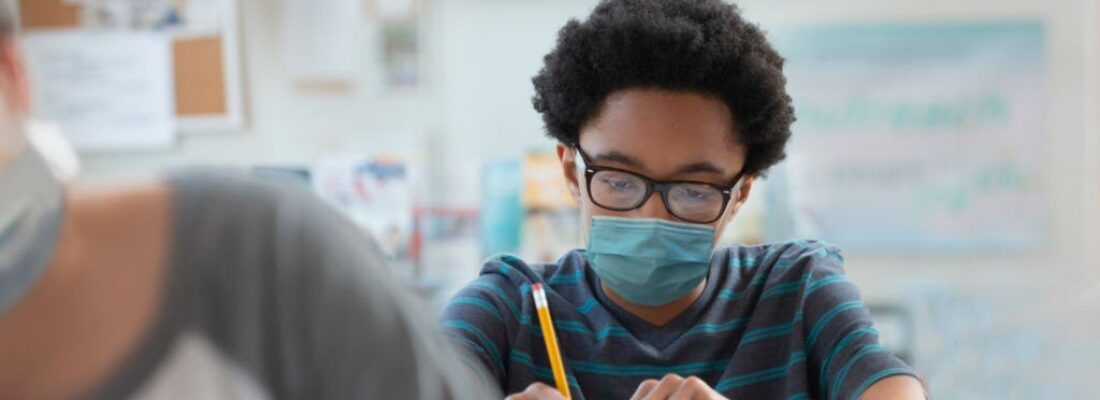Translational Science Benefits
Summary
The COVID-19 pandemic has posed significant challenges in providing healthcare services, such as testing and vaccinations, to underserved communities across the US. During the planning of the Safe Return to School Study in January 2021, there was limited information on COVID-19 transmission and prevention in K-12 schools.1-4 One prevention strategy recommended by the Centers for Disease Control and Prevention (CDC) was weekly SARS-CoV-2 testing for students and staff. Some data suggested that routine testing helped reduce COVID-19 outbreaks by identifying infected individuals and their close contacts, enabling appropriate isolation and quarantine measures.5 Further, as effective COVID-19 treatments became available, testing helped identify high-risk individuals who could benefit from antiviral treatment. In addition to testing, COVID-19 vaccinations have been highly effective, reducing hospitalizations and mortality by 80%.6 Unfortunately, vaccine uptake in the United States has been low, with only 56% of adults fully immunized as of April 2021, and 52% in ages 12-17 and 43% in ages 5-11 as of December 2021.7 Many researchers, including those at Washington University School of Medicine, the Washington University Brown School, and the CDC have explored strategies to improve public understanding and uptake of the COVID-19 vaccine.
This study aimed to address two questions to improve the health and safety of K-12 schools in underserved communities: 1) Does weekly screening testing in students, staff, and their household members at middle and high schools in predominantly Black communities in North County St. Louis reduce COVID-19 transmission; and 2) Which strategy or combination of strategies increase COVID-19 vaccine uptake among individuals who are either unvaccinated or not up-to-date.
To address the first question, a randomized trial was conducted in sixteen middle and high schools across five school districts. The trial provided students, staff, and their household members access to saliva-based molecular SARS-CoV-2 testing. The schools were randomized into two intervention groups: (1) Weekly screening and symptomatic testing or (2) symptomatic testing only. Those in the weekly screening testing group, which included eight middle or high schools, submitted a weekly test at their respective schools. Symptomatic testing was available across all five school districts including early childhood centers and elementary schools8. The primary outcome measured was the weekly rate of COVID-19 cases for each middle and high school.
In Spring 2022, another randomized trial was developed to address the second research question. This trial assessed the effectiveness of two different vaccine uptake strategies: (1) motivational interviewing (MI) or (2) receiving text messages with a link to a website containing educational videos designed for the predominantly Black population in St. Louis.9 Participants were randomly assigned to one of the two interventions. If they were not vaccinated after two weeks, they were again randomly assigned to one of the two interventions. For those in the MI group, a study coordinator who was formally trained in MI was matched to participants based on race and/or ethnicity. The research team hypothesized that individuals who received a high-intensity intervention, such as an MI, would be more likely to get vaccinated, compared to those who received a low-intensity intervention, like text messaging.10-15

Significance
In total, 11,927 COVID-19 tests were performed, including 9,415 weekly screening tests and 2,512 symptomatic tests. Out of all these tests, 367 were positive.
Beyond quantitative metrics, this study built meaningful partnerships with school and community partners. A Community Advisory Board was established to help conduct the study and to determine methods for disseminating findings. Additionally, the research team consistently communicated with school administrators to navigate the ever-changing COVID-19 pandemic effectively. Throughout the study, the research team worked diligently to address all questions from school administrators, community members, school staff, students, and families.
This study supplied COVID-19 testing to underserved communities throughout the early stages of the pandemic and during subsequent surges when tests were hard to obtain. Further, the MI and text message interventions provided participants with up-to-date pandemic information, including masking and vaccination guidance, quarantine protocols, and where to access resources. Individuals who tested positive during the study were given additional information on available medications and isolation procedures.
This study focused on historically underserved, predominately Black communities in North St. Louis County. The research team worked with schools to provide equitable access to resources that fit their unique needs. The team also partnered with local communities to identify and understand pandemic-related concerns, including testing, in-person learning, vaccination safety, and other challenges. These partnerships allowed interventions to be tailored to meet community needs and develop trust with study participants. Moreover, this study established and used a diverse research team with a range of interests in public health and medicine and supported under-represented minorities to establish careers in healthcare or medical research. One former research member of color is now in medical residency, five former research members of color have started medical school, and two current research members of color earned or are working towards their advanced clinical research degrees.
Benefits
Demonstrated benefits are those that have been observed and are verifiable.
Potential benefits are those logically expected with moderate to high confidence.
Provided saliva-based COVID-19 testing developed at Washington University in select schools in North County, St. Louis. demonstrated.
Clinical
Provided weekly COVID-19 testing to North St. Louis County community members. demonstrated.
Community
Increased the accessibility of COVID-19 testing in historically underserved areas in North St. Louis County. demonstrated.
Community
Conducted COVID-19 testing on a large scale, potentially lowering the spread of COVID-19 in North St. Louis County communities. potential.
Community
Aided in efforts to track COVID-19 transmission through large scale testing. demonstrated.
Community
Conducted motivational interviewing (MI) to increase vaccine uptake to reduce misinformation and provide resources on COVID-19 prevention and transmission. potential.
Community
Reduced cost barriers to COVID-19 testing by providing no-cost testing to participants. demonstrated.
Economic
This research has clinical, community, and economic implications. The framework for these implications was derived from the Translational Science Benefits Model created by the Institute of Clinical & Translational Sciences at Washington University in St. Louis.
Clinical
The research team provided a streamlined approach to testing and diagnosing COVID-19 in a timely, efficient, and accurate manner for North County St. Louis school communities (staff, students, households of staff and students, and school administrators). School communities participating in the study received saliva-based COVID-19 testing, with results within 24-48 hours in select schools and testing locations.
Community
This study increased access to COVID-19 testing on a large scale to reduce the spread of SARS-CoV-2 in school communities in North St. Louis County. It also gave school communities in predominantly Black districts a platform to ask questions and discuss concerns related to the pandemic. Additionally, this study helped provide and disseminate information on COVID-19 prevention, such as vaccination, masking, and social distancing. The research team engaged with school communities in various ways including participation in school events, conducting testing during the school day, and giving classroom presentations to students about infectious diseases.
By offering no-cost saliva-based tests, which were easier to use compared to a nasal test, the project team improved accessibility to COVID-19 tests in historically underserved areas of North St. Louis County. Further, the research team provided follow-up calls for every positive result, which allowed participants to consult with a Washington University physician to answer their questions and provide recommendations to keep their families safe.
Economic
Free testing was provided from May 2021 to March 2023 to school communities in North County St. Louis to staff, students, and their household members. While the exact economic benefit of preventing COVID-19 cases was not calculated, the testing costs alone amounted to $417,445.
Lessons Learned
School and Community Partnerships
Throughout the study, knowledge flowed equally between the school community and the study team. Together the study team and the school community discussed effective communication strategies, convenient testing times and locations, potential outreach methods, and how to meet community needs related to the pandemic.
Washington University Partnership
The ability for a majority of testing to be conducted at a Washington University lab was essential for timely and convenient testing. Outstanding communication was established between the lab and the testing and informatics teams, which allowed any issues to be resolved quickly. Additionally, Washington University’s Brown School provided critical expertise on building community partnerships, as well as the best communication strategies to conduct a successful and effective community-engaged study.
Reflection of the Community
The research team resembled and had similar backgrounds to community members participating in the study, which was important for representation and establishing trust, even when difficult.
- The Coronavirus Spring: The Historic Closing of U.S. Schools. Education Week. Published July 2, 2020.
- White P, Ceannt R, Kennedy E, O’Sullivan MB, Ward M, Collins A. Children are safe in schools: a review of the Irish experience of reopening schools during the COVID-19 pandemic. Public Health. 2021;195:158-160. doi:10.1016/j.puhe.2021.04.001
- Zimmerman KO, Akinboyo IC, Brookhart MA, et al. Incidence and Secondary Transmission of SARS-CoV-2 Infections in Schools. Pediatrics. 2021;147(4):e2020048090.
- U.S. Department of Health and Human Services, CDC. Operational strategy for K–12 schools through phased prevention. Atlanta, GA: CDC; May 15, 2021.
- Hockstein NG, Moultrie L, Fisher M, et al. Assessment of a Multifaceted Approach, Including Frequent PCR Testing, to Mitigation of COVID-19 Transmission at a Residential Historically Black University. JAMA Netw Open. 2021;4(12):e2137189.
- Fitzpatrick MC, Moghadas SM, Pandey A, Galvani AP. Two Years of U.S. COVID-19 Vaccines Have Prevented Millions of Deaths and Hospitalizations. Published online 2022.
- KFF COVID-19 Vaccine Monitor. KFF 2020 [updated 2023].
- Hayes S, Malone S, Bonty B, et al. Assessing COVID-19 testing strategies in K-12 schools in underserved populations: study protocol for a cluster-randomized trial. BMC Public Health. 2022;22(1):1177.
- Almirall D, Nahum-Shani I, Sherwood NE, Murphy SA. Introduction to SMART designs for the development of adaptive interventions: with application to weight loss research. Transl Behav Med. 2014;4(3):260-274.
- Michie S, van Stralen MM, West R. The behaviour change wheel: A new method for characterising and designing behaviour change interventions. Implementation Science. 2011;6(1):42.
- Beckwith VZ, Beckwith J. Motivational Interviewing: A Communication Tool to Promote Positive Behavior Change and Optimal Health Outcomes. NASN Sch Nurse. 2020;35(6):344-351.
- Gagneur A, Gosselin V, Dubé È. Motivational interviewing: A promising tool to address vaccine hesitancy. Vaccine. 2018;36(44):6553-6555.
- Gabarda A, Butterworth SW. Using Best Practices to Address COVID-19 Vaccine Hesitancy: The Case for the Motivational Interviewing Approach. Health Promot Pract. 2021;22(5):611-615.
- Cole JW, M H Chen A, McGuire K, Berman S, Gardner J, Teegala Y. Motivational interviewing and vaccine acceptance in children: The MOTIVE study. Vaccine. 2022;40(12):1846-1854.
- Frost H, Campbell P, Maxwell M, et al. Effectiveness of Motivational Interviewing on adult behaviour change in health and social care settings: A systematic review of reviews. PLoS One. 2018;13(10):e0204890.

